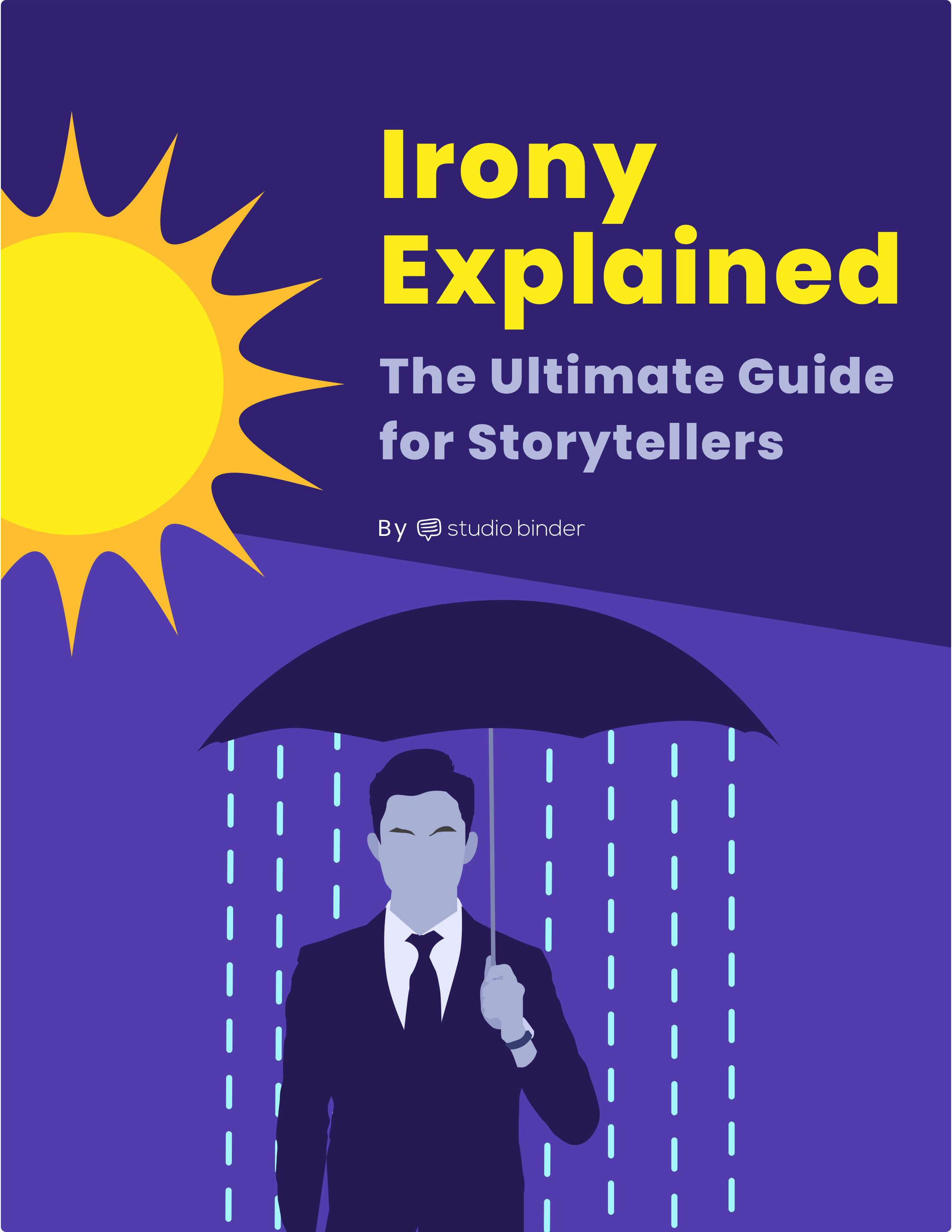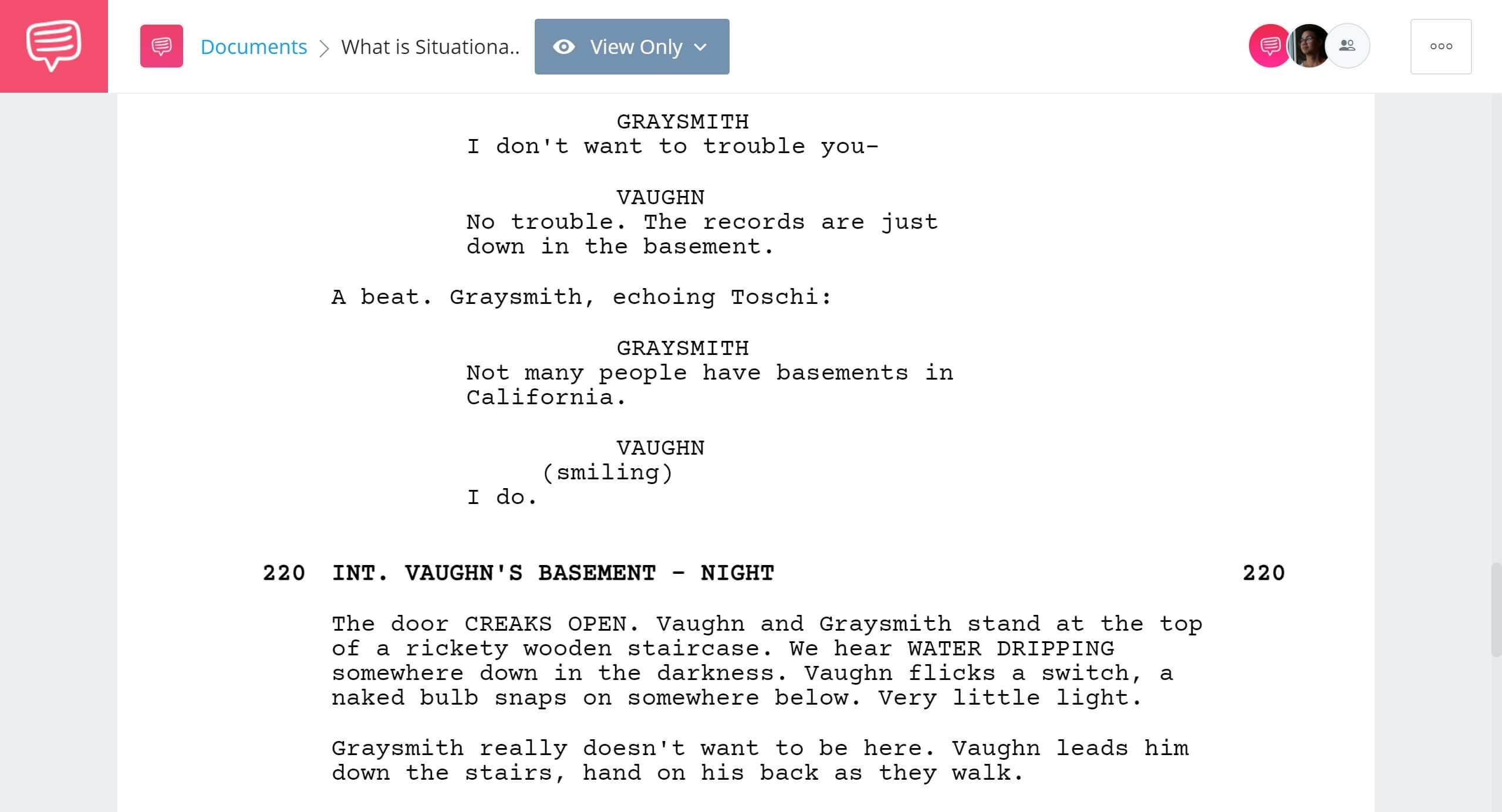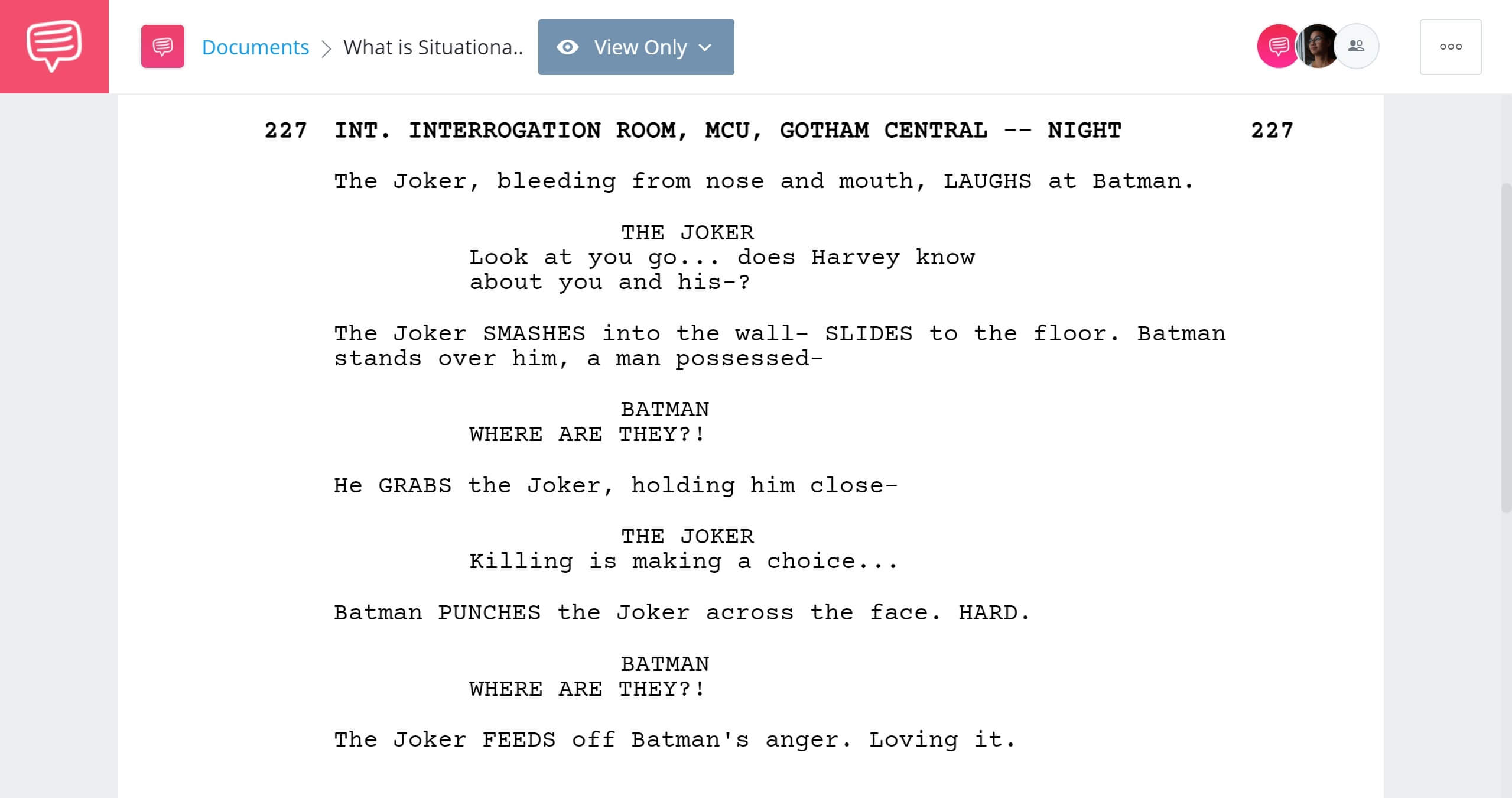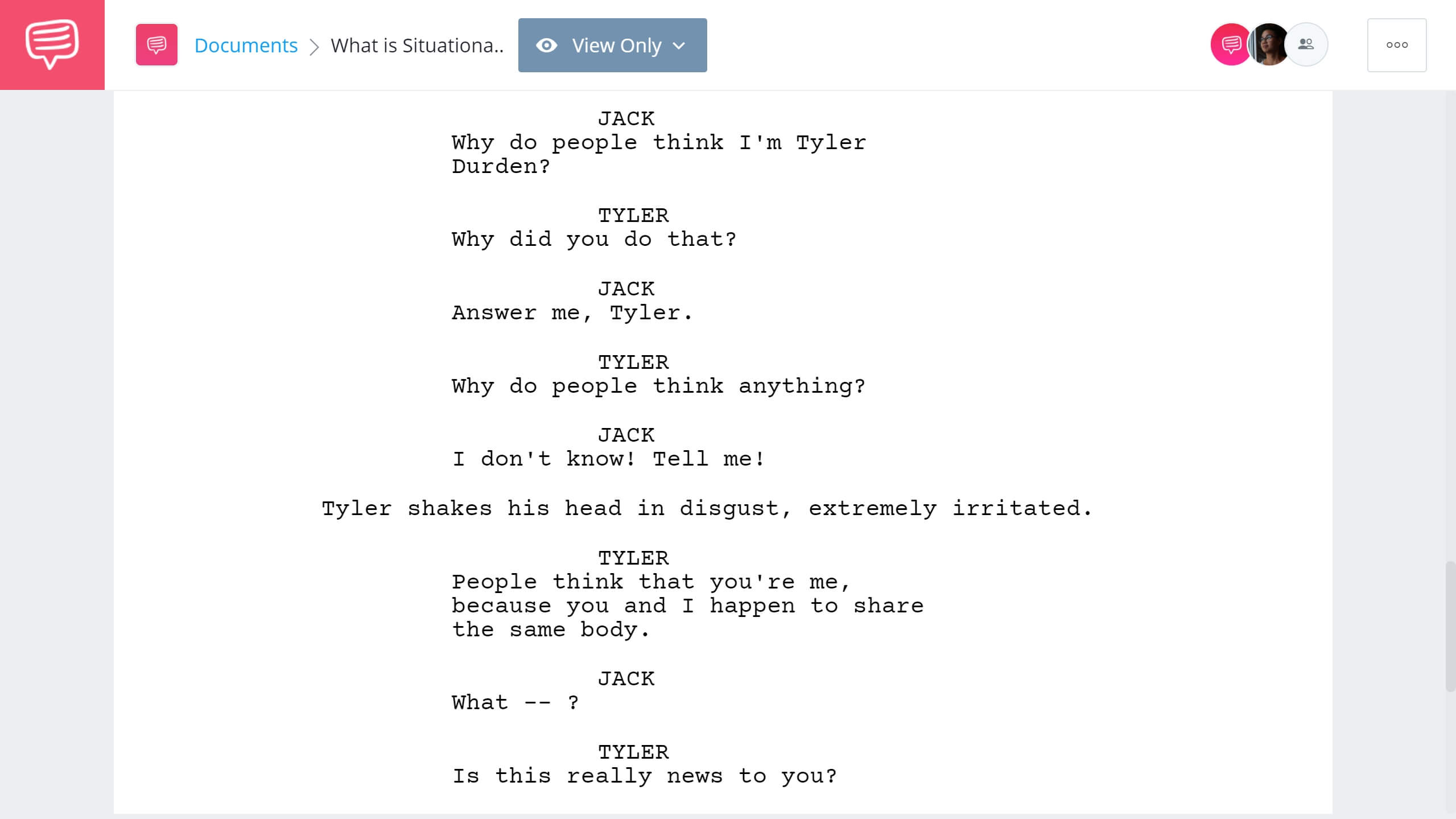Situational irony is a broad term with near-endless applications. At a fundamental level, every story has some aspect of situational irony – which means that it’s a key component of storytelling. But what is situational irony? We’re going to define situational irony by looking at situational irony examples in film and TV. By the end, you’ll understand how situational irony works – and how d you’ll be able to add intrigue and complexity to your storytelling.
What Does Situational Irony Mean?
Situational irony meaning explained
Situational irony is a very straight-forward concept – but it can be tricky to weave it into stories. Let’s listen to educator Christopher Warner explain situational irony in his own words.
Situational Irony Definition • Situational Irony Defined
Warner says “a situation is only ironic if what happens is the exact opposite of what was expected.” But how do we know what to expect? Well, that’s a difficult question to answer. Many anthropologists would say archetypes and social conditioning play an important role in knowing what to expect. But perhaps the best way to think of “knowing what to expect” is the maxim: you know it when you see it.
Below, we'll see this concept in action with some examples from film & TV but let's begin with a quick situational irony definition.
Define Situational Irony
What is situational irony?
Situational irony is when the opposite of what we expect to happen, happens. It can be as simple as bringing an umbrella outside only to find the sun shining. Or it can be as dramatic as revealing the killer to be the least likely suspect. It is the ultimate curveball to throw your audience — and, when done well, it can be supremely satisfying. Who doesn't love a shocking twist?
Subtypes of situational irony
- Cosmic irony (Irony of Fate)
- Poetic irony (Poetic justice)
- Structural irony
- Historical irony
For a complete guide to irony, download our FREE ebook covering the types of irony, examples, and how writers wield it.
Free downloadable bonus
FREE Download
Ultimate Guide to Irony
Irony is an essential literary device that all writers should master. Download our FREE e-book to get in-depth explanations and examples on topics like the major types and sub-types of irony, and the myriad of ways writers can use it to enrich their storytelling.
Situational Irony Definition Literature
What is situational irony in literature?
Situational irony has played an important role in literature and stage plays for hundreds of years. Here are a few situational irony examples in literature:
- In The Story of an Hour, Louise is told her husband is dead. But despite the morbid circumstance, and the fact Luise had no ill will towards her husband, she feels an overwhelming sense of joy. But when her husband returns alive, she suffers a heart attack and dies. This is an example of situational irony because it’s the opposite of what we’d expect from a grieving widow.
- In American Psycho, Patrick Bateman confesses to committing a series of murders – but is laughed off. This is an example of situational irony because we expect he’s going to be punished for his crimes but he isn’t.
- In Macbeth, the title character murders the king as a means to an end. But Macbeth soon finds out that he has to keep killing in order to protect his throne. This is an example of situational irony because the situation was meant to put an end to Macbeth’s killings, but in reality, it only exacerbated them.
Not every example of situational irony is as grandiose as these are. Most situational irony examples are subtle. Let’s dive into some more situational irony examples in film and TV to find out.
Situational Irony Synonyms and Antonyms
Situational vs. dramatic irony
In movies and television, we need situational irony to keep things unexpected and interesting. It would be extremely boring if everything always turned out how we expected. That’s not how real life works and it’s not how fictional entertainment works either.
One of the biggest questions involves the difference between dramatic and situational irony. In this section, we’ll set the record straight. Dramatic and situational irony both involve the difference between expectations and reality. The element that makes them different is time.
With situational irony, we learn at the same time as the characters that our expectations were different than reality. With dramatic irony, we know in advance that the character's expectations are not the reality of the situation. And that creates tension.
We'll cover dramatic irony in more detail in a different post.
Let's move onto some situational irony examples that will help understand this concept even further. As you'll see, there are many ways to employ this form of irony — for humor, suspense, or drama.
What is Situational Irony Used For?
Use situational irony for suspense
Let's jump into a quick example of situational irony from one of David Fincher’s best movies: Zodiac. In this example, we expect something sinister to happen. But when it doesn’t, our expectations are upset. We imported the Zodiac screenplay into StudioBinder’s screenwriting software to take a closer look at the scene in question.
What is Situational Irony? • Situational Irony in the Zodiac Script
Here, we expect Vaughn to kill Graysmith. Why? Two reasons: one, because Vaughn – in the eyes of Graysmith – all but confirms he’s implicated in the Zodiac killings; and two: we’re bombarded with horror tropes. So when Vaughn doesn’t kill Graysmith, we’re shocked. This shock, or failure to meet expectations, is the reason why we consider the moment an example of situational irony. If you’ve never seen the scene before, check out the clip below. It’s one of the all-time great suspense scenes in all of cinema.
Situational Irony Examples • Zodiac
If you want to use situational irony in your own works, consider what Fincher did; take a common trope and subvert it in a situational way.
How to Use Situational Irony for Laughs
Add situational irony for humor
If you’ve seen the game show The Price is Right, you know that its long-time host, Bob Barker, had one of the sweetest and kindness personas.
So, it made sense that when he popped up in Adam Sandler’s Happy Gilmore, we expected him to act like that same character. Instead, we got Barker throwing punches and profanities — completely hilarious, and completely unexpected.
Situational Irony Examples • Happy Gilmore
Situational irony is a great tool for upsetting character expectations. For example: if we think a character is stupid, but they prove to be smart, then we can say situational irony has been deployed. Consequently, if a character simply affirms their archetypal qualities, then we can say they aren’t well-rounded – and that no situational irony has been deployed.
Perhaps my favorite example of situational irony can be found in This is Spinal Tap when a certain prop arrives to the set smaller than expected. If you haven’t seen Spinal Tap’s Stonehenge scene, check it out below.
Situational Irony Definition • This is Spinal Tap
Here, the members of Spinal Tap are shocked to find that their prop is tinier than expected – but hey, that’s what happens when you don’t distinguish inches from feet.
Situational Irony Defined in Drama
Apply situational irony for drama
In The Dark Knight, the Joker kidnaps District Attorney Harvey Dent and Bruce Wayne’s on-and-off-again girlfriend Rachel. When The Joker gives Batman their locations, we believe he’s forcing Batman to choose between love (Rachel) and logic (Dent).
[SPOILER ALERT]
Let’s dive into The Dark Knight screenplay to see who Batman chooses to save. As you’re reading, pay close attention to how screenwriters Jonathan Nolan, Christopher Nolan, and David S. Goyer subvert expectations with the situation.What is Situational Irony? • Situational Irony in The Dark Knight
And he is, just not exactly how we expect...he switched their addresses so Batman ends up saving Harvey instead of Rachel. A cruel use of situational irony, indeed.
In the next section, we’ll define the various permutations of situational irony so you can see how intricate and nuanced this concept is.
Cosmic Irony Definition
How to use cosmic irony
Cosmic irony is just one subtype of situational irony – and it's defined by the inclusion of a supernatural twist. We still have a situation in which reality and expectation are different but there is an additional element — a "higher power" is involved.
This higher power could be God, the Universe, fate, or even aliens. Cosmic irony is also known as "irony of fate," which might help give you an idea of how it all works.
In Monty Python’s The Life of Brian, the title character falls off of a tall building, but is rescued by an alien ship. Check out the scene below.
Cosmic Irony Definition • The Life of Brian
Here, the Pythons largely satirized cosmic irony. Many instances of cosmic irony devolve into deus ex machina, aka a hopeless situation that’s resolved in a contrived way – but this example succeeds due to its use of satire. There is a lot more to explore with cosmic irony, including examples from movies and TV.
Learn more about cosmic irony →
Define Situational Irony Subtypes
How to use poetic irony
Poetic irony (a.k.a poetic justice) is another subtype of situational irony – and it just might be the most satisfying for the audience. Poetic irony occurs when a crime or transgression is unexpectedly resolved positively, often due to a ‘twist of fate.’
In The Killing, the heist of a horse racetrack is perfectly planned and executed. In the end, karma visits Johnny Clay when he is mere minutes away from escape. While waiting for the plane, a dog runs onto the tarmac and the driver of the luggage cart swerves. Johnny’s suitcase falls and $2 million in cash gets sent flying in every direction.
Situational Irony Examples • Poetic Irony in The Killing
There is a lot more to explore with poetic irony, including examples from movies and TV. Check out our article on poetic irony below.
Learn more about poetic irony →
Define Situational Irony Subtypes
How to use Structural irony
Structural irony is a subtype of situational irony – and it can have two very different effects whether it's used in comedy or drama. Structural irony occurs when the perspective of an unreliable narrator or naive protagonist is different from the reality of the situation.
In some cases, the unreliable narrator may simply be lying to the audience; or they may have convinced themselves of a faulty truth. Either way, when the entire story is built around this ignorance or deception, you get structural irony.
[SPOILERS AGAIN]
Perhaps no movie gives us a narrator more clearly unreliable than Fight Club. Let’s check out the Fight Club screenplay to see where the narrator learns he’s been living a lie.Situational Irony is Exposed in Fight Club
In this scene, the narrator realizes he’s Tyler Durden. Everything up to this point has been warped through the lens of an unreliable narrator. As such, we can say Fight Club is an example of structural irony. If you want to review the scene from the film, you can watch it below.
Situational Irony Examples • Fight Club Clip
If you want to use structural irony in your own screenplay, consider using an unreliable narrator like Tyler Durden from Fight Club. There is a lot more to explore with structural irony, including examples from movies and TV.
Learn more about structural irony →
Define Situational Irony Subtypes
Historical irony
Historical irony is our final subtype of situational irony. As the name suggests, it has more to do with actual history than fiction but can still be used for deep and profound reasons in your storytelling.
Historical irony occurs when hindsight provides an ironic perspective on an action or stance made in the past. Hindsight is 20/20, right?
At the end of The Social Network script, Mark Zuckerberg finds himself alone, reaching out to someone he once had a connection with — perhaps the only person he ever had a chance of connecting to. The metaphor and use of historical irony in this scene is exquisitely executed.
What is Situational Irony? • Situational Irony in The Social Network
Historical irony is a useful tool for wrapping up the major and minor themes of a movie. There’s a lot more to explore with historical irony, including examples from movies and TV in our next article.
Learn more about historical irony →
UP NEXT
Dive deeper into irony
We've covered the basics of situational irony but there is so much more to learn. If there is a particular form of irony you want to explore further, just follow the navigation below. Each one of these subtypes of irony belongs in every writer's toolkit.




